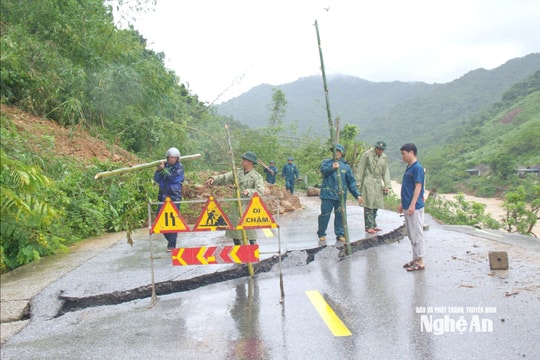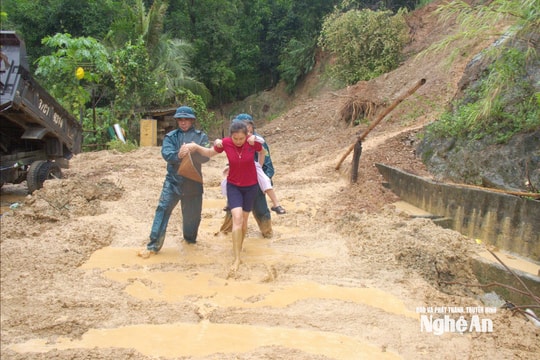Nghe An: Farmers focus on restoring production after storm No. 10
Storm No. 10 has affected agricultural production in Nghe An province. Currently, along with drainage, local farmers are focusing on overcoming and reducing productivity losses.
Farmers try to "save" crops
Flooding rain and strong winds caused by storm No. 10 caused 2 sao of rice fields of Mrs. Hoang Thi Son's family in Tay Van hamlet, Nghi Loc commune to collapse and become submerged in water. From the morning of September 30, when the weather gradually cleared up, she went to the field to set up and tie the rice to get ready for a quick harvest.
.jpg)
Nghi Van commune has more than 1,350 hectares of summer-autumn rice, of which more than 30 hectares are summer-autumn rice. Before storm No. 10, the whole commune had harvested more than 1,200 hectares of summer-autumn rice. Heavy rains flooded the entire summer-autumn rice area and 160 hectares of ripe summer-autumn rice that had not yet been harvested in Tay Van and Dong Lang hamlets...
Ms. Nguyen Thi Hai Linh - an expert from the Economic Department said: Since the morning of September 30, people have been harvesting by hand, saving productivity. As for 30 hectares of winter-spring rice in hamlets 3, hamlets 4..., because they are in the green stage, they are almost not falling over and do not lose productivity like summer-autumn rice. However, if they are soaked in water for more than 2 days, the roots will be clogged, affecting their development. The commune is mobilizing forces, focusing on clearing canals, draining water quickly to avoid flooding, and saving the rice.

After the storm, Minh Chau commune suffered damage to more than 25 hectares of cucumbers and more than 20 hectares of chives and onions. Currently, the commune is focusing on draining water, directing and advising people to treat ponds, disinfect the environment after the water recedes, and then replant. As for various crops, wait for the water to recede and the soil to dry before planting again; in particular, the area of chives will have a plan to switch to growing other crops such as corn and beans because chives are not only expensive but also very difficult to buy.
On this occasion, Yen Trung commune has 40 hectares of ornamental peach trees, 2,000 fruit trees of all kinds, 15 hectares of cajuput and eucalyptus trees that were uprooted and broken. Of which, ornamental peach trees are the main source of income for the people after switching from lemon trees to peach trees to increase production value 5 years ago, with an average income of 600 - 800 million VND/year per hectare.
The floodwaters knocked down 500 peach trees in the garden of Mr. Ha Manh Hiep's family in Yen Trung commune. Currently, the whole garden only has about 150 peach trees with strong roots that can cling to the ground. Immediately after the storm, he went to the garden to rebuild and take care of the trees. However, these peach trees are not expected to bloom in time for Tet this year because, according to Mr. Hiep, peach trees with broken roots will bloom early and cannot be stopped.

Mr. Pham Ngoc Cu - Chairman of the Commune People's Committee said: Currently, the forces are focusing on pruning and cleaning up fallen forestry trees to ensure the development of the remaining areas, then replanting will be carried out. The highlands producing winter crops will reproduce when the water recedes; the low-lying, flooded areas will raise fish for the third crop. "Regarding livestock farming, the commune will guide and advise people to disinfect barns to restore the herd, and households with heavy losses will have a support mechanism to facilitate people to buy new breeds," said Mr. Pham Ngoc Cu.
Focus on drainage and production restoration
Before storm No. 10, Nghe An's summer-autumn rice area had basically been harvested, and the whole province had also planted nearly 4,000 hectares of winter crops. However, the winter-spring rice area was severely affected.
According to quick statistics from the Department of Agriculture, the storm's impact damaged 4,480 hectares of rice, 6,062 hectares of vegetables, 4,174 hectares of perennial crops, 4,897 hectares of annual crops and 674 hectares of concentrated fruit trees.
Localities and units need to focus on drainage, clearing riverbeds and drainage axes to ensure good drainage and flood protection, protecting rice fields, crops, fruit trees, and industrial trees; in which priority is given to quickly pumping and draining water for areas at risk of severe flooding, fruit trees, rice fields, and vegetables ready for harvest.

According to Mr. Nguyen Tien Duc - Head of the Provincial Department of Crop Production and Plant Protection: For the winter-spring rice fields in the milky ripening - waxy ripening period, after the rain stops, focus on draining water to prevent the rice from being flooded for a long time, and proceed to erect the rice by gathering 3 - 4 rice stalks together to form a tripod shape to make the plants stand, to create favorable conditions for the rice to become firm and ripen.
For crop fields, focus on clearing water flow, dredging ditches and drainage ditches in newly planted vegetable fields that are not yet ready for harvest; prepare enough quantity and types of seeds to replant in areas damaged by heavy rains. However, farmers should note to only plant when the weather is dry.
At the same time, for industrial trees and perennial fruit trees, it is necessary to dig trenches and focus on pumping water out of the garden quickly; for trees with broken branches, use a specialized saw to cut the broken branches, clean the field, and at the sawing location, use lime water or a root fungicide solution to brush into the saw cuts to limit the harmful effects of fungi penetrating into the branches.
In addition, increase the use of organic fertilizers and foliar fertilizers to supplement the tree's recovery ability; lightly till and break the crust on the top layer of soil in the canopy to help the soil aerate, creating air exchange above and around the roots. Severely damaged trees are difficult to recover, so it is necessary to have a plan to use quality seedlings for new planting.





-3b0672fed9b9276f8d02c910e92a6626.jpeg)
